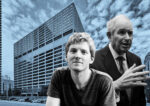Downtown Chicago’s office market just blew past another grim milestone. The vacancy rate climbed to 26.5 percent in the first quarter, the 11th consecutive quarter of record-high availability, Crain’s reported.
The pace of tenant shrinkage is slowing. Vacancy rose just 0.2 percent from the fourth quarter, according to CBRE. But that’s not enough to reverse the damage.
Remote work and corporate downsizing have left the central business district with more than 2.1 million fewer square feet of leased space since the start of the pandemic. That’s contributed to widespread foreclosures and deep property devaluations as landlords struggle to retain tenants, refinance debt and justify further capital investments.
There were some signs of stabilization to start the year. Net absorption, the change in leased and occupied space, turned positive for the first time since mid-2023, rising by 56,000 square feet.
Tenants including Stripe, Blue Owl Capital and law firm Goldman Ismail signed significant office expansions downtown.
Meanwhile, investors have begun picking up distressed buildings at steep discounts, betting that the market has bottomed out. But many have other plans, leveraging the office-to-residential conversion wave sweeping downtown, backed by city subsidies.
The divide between newer and older buildings continues to widen, as the “flight to quality” trend continues. The vacancy rate for Class A buildings is just under 21 percent, compared with 32 percent for older Class B offices. Arnold & Porter and JBT Marel recently relocated to renovated towers 300 North LaSalle and 333 West Wacker, for example.
Sublease space is down to 5.6 million square feet from 8 million at the end of 2023, but availability is well above pre-pandemic levels. With capital tight and many buildings underwater on their loans, finalizing lease deals is a slow, often lender-constrained process.
No new office buildings were delivered downtown last quarter, but the only project still underway, 919 West Fulton, is set to deliver soon in the trendy Fulton Market neighborhood.
— Judah Duke
Read more



